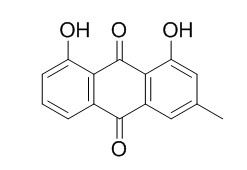Natural Products
Chrysophanol
| Catalog No. | CFN98751 |  |
| CAS No. | 481-74-3 | |
| Molecular Weight: | 254.2 | |
| Molecular Formula | C15H10O4 | |
| DBs | [PubChem]:274951753 [ChEMBL]:3687 [PCIDB]:568 |
Standard InChI:
InChI=1S/C15H10O4/c1-7-5-9-13(11(17)6-7)15(19)12-8(14(9)18)3-2-4-10(12)16/h2-6,16-17H,1H3
Biological Activity
Chrysophanol has anti-inflammatory activity through the suppression of NF-κB/caspase-1 activation in vitro and in vivo.[1]
Chrysophanol induces necrosis through the production of ROS and alteration of ATP levels in J5 human liver cancer cells.[2]
Chrysophanol has mild cytotoxicity and anti-diabetic properties, it up to 100 microM exerts mild glucose transport activity and elevates the tyrosine phosphorylation of IR via tyrosine phosphatase 1B inhibition (IC50=79.86+/-0.12 microM), thus it could play metabolic roles in the insulin-stimulated glucose transport pathway.[3]
Chrysophanol and physcion, are main active compounds of the plant Baill, has is active against plant powdery mildew, and physcion is much more bioactive than chrysophanol against these powdery mildews.[4]
Chrysophanol can inhibit NALP3 inflammasome activation and ameliorate cerebral ischemia/reperfusion in mice.[5]
Product
References
[1] Sujin K, Mincheol K, Byongjoo L, et al. Molecules, 2010, 15(9):6436-51.
[2] Lu C C, Yang J S, Huang A C, et al. Mol Nutr Food Res, 2010, 54(7):967–76.
[3] Lee M S, Sohn C B. Biol Pharm Bull, 2008, 31(11):2154-7.
[4] Yang X, Yang L, Wang S, et al. Pest Manag Sci, 2007, 63(5):511-5.
[5] Zhang N, Zhang X, Liu X, et al. Mediat Inflamm, 2014, 2014(1):289-339.
[6] Tang W F, Yu Q, Wan M H, et al. Biomed Chromatogr, 2007, 21(7):701-7.
Product Use Citation





